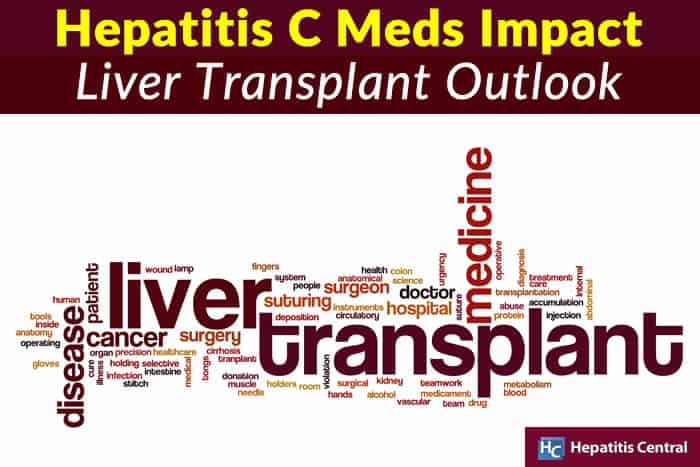Hepatitis C Meds Impact Liver Transplant Outlook


The evolution of direct-acting-antivirals (DAA) for treating Hepatitis C infection has progressed enormously in the past several years. In addition to DAA’s extremely high success rate at eliminating the Hepatitis C virus from the bloodstream, these medications can also reverse damage to the liver. This additional benefit of treating Hepatitis C even applies to people with a severe enough form of liver disease to be on the liver transplant list. New research shows that treatment with DAAs can remarkably improve the liver function of patients with decompensated cirrhosis, allowing the delisting of 1 out of 5 patients on the liver transplant waitlist.
Decompensated Cirrhosis and MELD
Decompensated cirrhosis is when the liver is extensively scarred and unable to function properly. Without treatment, chronic liver disease can progress to decompensated cirrhosis, which is typically defined by the development of one of the following:
- Jaundice (yellowing of the eyes and skin)
- Ascites (fluid accumulation in the abdomen)
- Variceal hemorrhage (internal bleeding)
- Hepatic encephalopathy (confusion due to liver toxicity)
By the time a person has decompensated cirrhosis, they likely need a liver transplant to increase their odds for survival.
The model for end-stage liver disease (MELD) score is a way to grade the severity of cirrhosis. The MELD score is based on three commonly obtained laboratory parameters:
- serum bilirubin
- serum creatinine
- and international normalized ratio.
The United Network for Organ Sharing (UNOS) adopted the MELD score in 2002 to prioritize allocation of organs for liver transplantation. The MELD score ranges from 4 to 60 points, with higher scores correlating with a lower three-month survival. Patients with cirrhosis and a MELD score of 10 or greater are advised to seek a liver transplantation evaluation.
MELD, DAA and Delisting
According to a European study published in the September 2016 edition of the Journal of Hepatology, around a quarter of people with Hepatitis C and decompensated cirrhosis came off liver transplant waiting lists after DAA treatment. Being removed from the liver transplant waiting list means that liver repair occurred, despite the long-standing belief that damage incurred from cirrhosis is permanent.
The study recruited 142 Hepatitis C patients with decompensated cirrhosis who were candidates for liver transplantation and who underwent direct-acting-antiviral treatment between February 2014 and June 2015.
Of the recruits:
- 46% received treatment with sofosbuvir (Sovaldi) plus ribavirin
- 54% received either sofosbuvir plus daclatasvir (Daklinza) or sofosbuvir/ledipasvir (Harvoni)
Participants were followed for over two years, including their time on treatment, during which time half underwent a liver transplant. However, an astonishing 24% of participants were delisted from the liver transplant list.
Delisting:
- was strongly associated with a baseline MELD score below 16.
- also occurred in a small number of patients with higher MELD scores.
Delisted patients experienced significant improvement in liver-related outcomes over time. The average follow-up after delisting was 58 weeks.
- MELD score decline – The median MELD score declined dramatically from 14 at baseline to 9 at the last follow-up visit.
- Ascites decline – Patients with any ascites fell from 82% at baseline to 24% at the last follow-up visit.
- Hepatic encephalopathy reduction – Hepatic encephalopathy almost disappeared, with 29% experiencing mild hepatic encephalopathy at baseline to 3% at the last follow-up visit.
The therapeutic value of the DAAs is likely to save many lives in two ways:
- The DAAs being used for Hepatitis C (Harvoni, Sovaldi and Daklinza) can kill the Hepatitis C virus and reverse cirrhosis.
- The delisting of decompensated cirrhosis patients will free up more livers for other transplant candidates.
The concept that Hepatitis C treatment is powerful enough to eliminate the virus AND reverse cirrhotic liver damage is exciting. Based on this study’s results, all oral DAAs were able to reverse liver dysfunction. However, those with lower MELD scores have a higher chance of being delisted.
There is no doubt that DAA therapy is changing the impact of Hepatitis C. The study demonstrating the delisting of patients with decompensated cirrhosis from the UNOS registry is a big deal – and is bound to qualify patients for therapy quicker, improve the health of those who have lived with the virus for decades, and reduce the wait time for those in dire need of a liver transplant.
http://onlinelibrary.wiley.com/doi/10.1111/apt.13798/full, Optimal timing for hepatitis C therapy in US patients eligible for liver transplantation: a cost-effectiveness analysis, B. Njei, et al, Retrieved July 2, 2017, Alimentary Pharmacology and Therapeutics, September 2016.
http://onlinelibrary.wiley.com/doi/10.1002/hep.29137/full, Treatment of patients waitlisted for liver transplant with all-oral direct-acting antivirals is a cost-effective treatment strategy in the United States, A. Ahmed, et al, Retrieved July 2, 2017, Hepatology, July 2017.
https://www.hepatitis.va.gov/patient/complications/cirrhosis/decompensated.asp, What is Decompensated Cirrhosis?, Retrieved July 2, 2017, US Department of Veteran Affairs, 2017.
http://www.hepatitisc.uw.edu/go/evaluation-staging-monitoring/evaluation-prognosis-cirrhosis/core-concept/all, Evaluation and Prognosis of Patients with Cirrhosis, Karla Thornton, MD, MPH, Retrieved July 2, 2017, Hepatitis C Online – AWS, 2017.
http://www.hivandhepatitis.com/hcv-disease-progression/hcv-liver-cancer-hcc/6055-easl-2017-hepatitis-c-treatment-allows-1-in-4-to-come-off-liver-transplant-waiting-list, EASL 2017: Hepatitis C Treatment Allows 1 in 4 to Come Off Liver Transplant Waiting List, Keith Alcom, Retrieved July 2, 2017, hivandhepatitis.com, 2017.
https://www.ncbi.nlm.nih.gov/pubmed/27212241, Delisting of liver transplant candidates with chronic hepatitis C after viral eradication: A European study, Belli LS, et al, Retrieved July 2, 2017, Journal of Hepatology, September 2016.
https://www.ncbi.nlm.nih.gov/pubmed/28348470, Potential Liver Transplant Recipients with Hepatitis C: Should They Be Treated Before or After Transplantation?, S. Vihar, Retrieved July 2, 2017, Journal of Clinical and Experimental Hepatology, March 2017.







